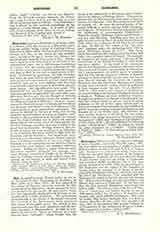
Alexis-François Rio
French writer on art, b. on the Island of Arz, May 20, 1797; d. June 17, 1874

Rio, ALEXIS-FRANCOIS, French writer on art, b. on the Island of Arz, Department of Morbihan, May 20, 1797; d. June 17, 1874. He was educated at the college of Vannes, where he received his first appointment as instructor, which occupation however proved to be distasteful. He proceeded to Paris, but was temporarily disappointed in his hope of obtaining there a chair of history. His enthusiastic championship of the liberty of the Greeks attracted the attention of the Government, which appointed him censor of the public press. His refusal of this appointment won him great popularity and the life-long friendship of Montalembert. In 1828 he published his first work, “Essai sur l’histoire de l’esprit humain dans l’antiquite”, which brought him the favor of the minister de La Ferronays and a secretariate in the Ministry of Foreign Affairs. This position allowed him (as Montalembert later wrote to him) to become for Christian, what Winckelmann had been for ancient, art. He spent the greater portion of the period 1830-60 in travels through Italy, Germany, and England. In Munich he became acquainted with the spokesmen of contemporary Catholicism—Boisseree, Baader, Dollinger, Gorres, and Rumohrand also with Schelling. Schelling gave him an insight into the aesthetic ideal; Rumohr directed him to Italy, where the realization of this ideal in art could be seen. In 1835 the first volume of his “Art chretien” appeared under the misleading title, “De la poesie chretienne—Forme de Fart”. This work, which was received with enthusiasm in Germany and Italy, was a complete failure in France. Discouraged, he renounced art study and wrote a history of the persecutions of the English Catholics, a work which was never printed. As the result of his intercourse with the Pre-Raphaelites of England, where he lived for three years and married, and especially of Montalembert’s encouragement, he visited again, in company with his wife, all the important galleries of Europe, although he had meanwhile become lame and had to drag himself through the museums on crutches. Prominent men like Gladstone, Manzoni, and Thiers became interested in his studies, which he published in four volumes under the title “L’art chretien” (1861-7). This work is not a history of all Christian art, but of Italian painting from Cimabue to the death of Raphael. Without any strict method or criticism, he expresses preference for the art of the fifteenth century, not without many an inexact and even unjust judgment on the art of later ages; but, in spite, or rather on account of this partiality, he has contributed greatly towards restoring to honor the forgotten and despised art of the Middle Ages. Rio describes the more notable incidents of his life in the two works, “Histoire d’un college breton sous l’Empire, la petite chouannerie” (1842) and “Epilogue a fart chretien” (2 vols., Paris, 1872). He also published the following works: “Shakespeare” (1864), in which he claims the great dramatist as a Catholic; “Michel-Ange et Raphael” (1867); “L’ideal antique et l’ideal chretien” (1873).
B. KLEINSCHMIDT

